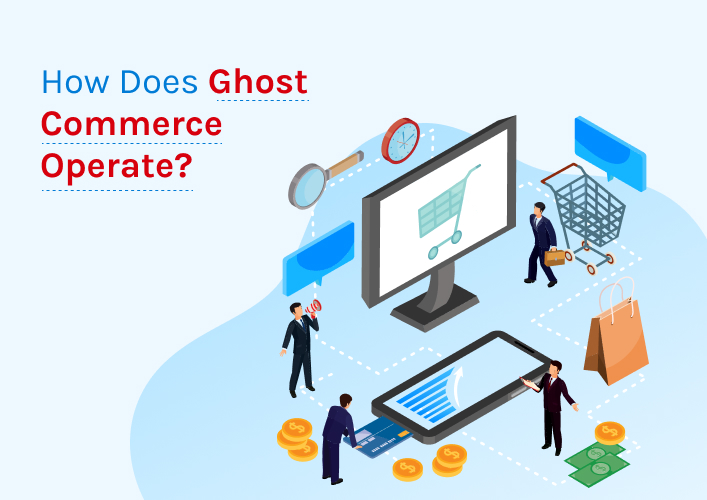What Do You Mean By Ghost Commerce?
Ghost commerce is the practice of doing business over the Internet without maintaining a physical location. Dropshipping, influencer marketing, and affiliate marketing are all related to this strategy in some way. A ghost e-commerce business is one that advertises items and sends clients to other stores rather than creating its own storefront offering its own products or fulfilling orders.
The word “ghost” is used since these stores do not exist in any digital or physical form. They are the supporters who help businesses like retailers and manufacturers sell more of their products online.
How does Ghost Commerce work?

When it comes to sales and advertising, Ghost Commerce has you covered. Those in the creative economy who have mastered the art of networking will find this a great business model. Ghost e-commerce entrepreneurs put their money into growing a customer base rather than opening physical locations.
Some business owners may struggle to get their heads around the idea of ghost e-commerce. In place of constructing a standard online store, you promote goods and services, provide product recommendations to clients, and use strategies like affiliate marketing.
If you don’t want to invest in or manage a physical retail location but still want to sell things and make cash, you may serve as a middleman. You don’t offer things directly in a shop, but instead promote the products of other firms or have products developed for you by other manufacturers. You can use methods like shopping links and cart pages to close the deal. The success of your ghost e-commerce hinges on your ability to influence the purchasing habits of internet shoppers. This way you may earn a respectable income.
What are the ways to make sales through Ghost Commerce?
There aren’t many ways to achieve success in ghost commerce since it’s still a novel idea.
- The first way is to establish yourself as an authority in your field in the digital sphere, either via your own website or other social media channels. As a supplementary source of income, influencers might use this strategy to direct their social media followers to a different online store.
- Customers may be directed to affiliate links and product suggestions using methods like content marketing with SEO (Search engine optimization). In addition, ghost merchants often use methods such as ads and email marketing.
- In order to increase awareness of the goods you’re selling, you can team up with other influential people. However, in order to earn a fee for your suggestions, you must build solid partnerships with manufacturers and other businesses.
- To better understand consumer tastes and motivate sales, data research plays a critical role. Your marketing plan will be more effective if you take the time to learn as much as possible about your target audience’s demographics, interests, and purchasing habits.
What are the pros and cons of Ghost E-commerce?
- Pros: A ghost commerce business takes the hassle out of running an online shop. You are spared the hassle of managing product listings, stock, orders, and deliveries. Furthermore, making a profit is possible with little to no outlay of capital. Depending on the effectiveness of your marketing plan, it may even be used to generate cash with little effort on your part. This means that those who have mastered influencer marketing and other related tactics may use them as a viable source of supplemental income.
- Cons: In order to succeed as a ghost commerce store, you must always keep your reputation in mind. Your credibility may take a hit if the product you suggest turns out to be worse. In most cases, you will only have a small percentage of the sales made.
What is the difference between dropshipping and Ghost Commerce?
Dropshipping refers to a technique of retail fulfillment in which a retailer does not hold inventory of the things it sells but holds an online storefront. On the other hand, ghost e-commerce doesn’t require a Shopify store or any other ecommerce store to sell. You are just a middle person selling the items of other manufacturers or stores through your network.
Conclusion
The rise of e-commerce platforms and the creative economy has increased interest in ghost e-commerce which may mediate between buyers and sellers online. With the help of ghost commerce, producers and merchants can reach more customers than ever before. On the other hand, business owners may earn a fortune with minimal risk and starting capital. However, it might be challenging. When you don’t have a storefront, it’s tough to attract customers and set yourself apart from the competition.
If you already have a sizable following online and know your way around affiliate marketing, influencer marketing, and content, ghost commerce may be the best route for you to take.
FAQs
Can you really make money with Ghost Commerce?
Is Ghost Commerce like dropshipping?
Do you need a storefront in ghost e-commerce?
How much capital is needed in ghost e-commerce?
What is an example of a ghost e-commerce?
Ravi Bhojani is the Chief Marketing Officer (CMO) at Alian Software, where he spearheads the company’s marketing strategies and drives its brand presence in the competitive IT services landscape. With over a decade of experience in the technology and marketing sectors, Ravi has consistently demonstrated his ability to blend innovative marketing techniques with deep industry knowledge to deliver outstanding results.